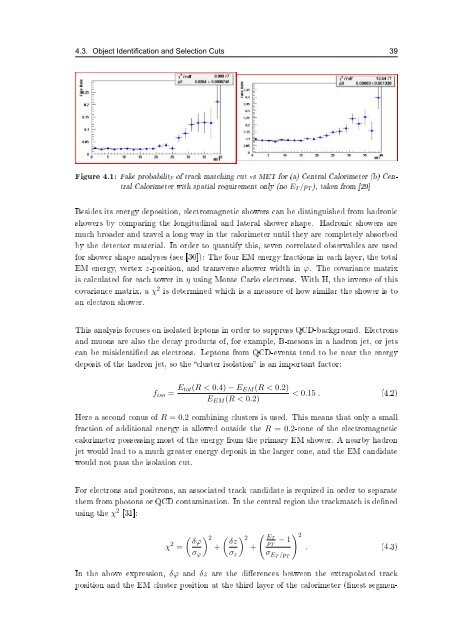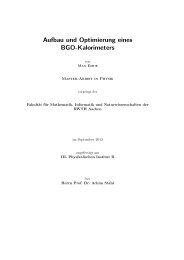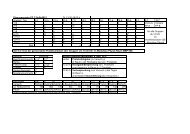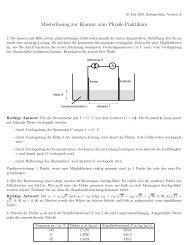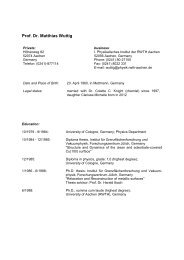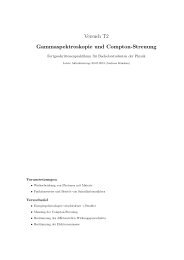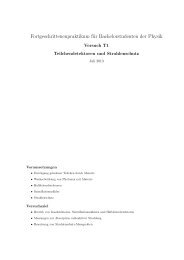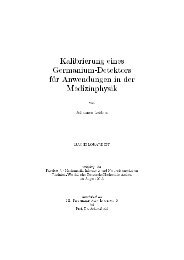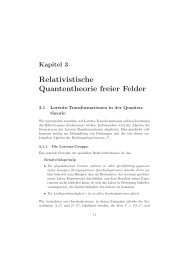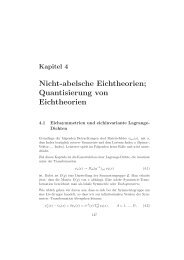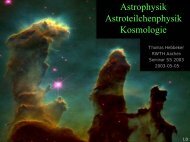Model Independent Search for Deviations from the Standard Model ...
Model Independent Search for Deviations from the Standard Model ...
Model Independent Search for Deviations from the Standard Model ...
Create successful ePaper yourself
Turn your PDF publications into a flip-book with our unique Google optimized e-Paper software.
4.3. Object Identification and Selection Cuts 39<br />
Figure 4.1: Fake probability of track matching cut vs MET <strong>for</strong> (a) Central Calorimeter (b) Central<br />
Calorimeter with spatial requirement only (no E T /p T ), taken <strong>from</strong> [29]<br />
Besides its energy deposition, electromagnetic showers can be distinguished <strong>from</strong> hadronic<br />
showers by comparing <strong>the</strong> longitudinal and lateral shower shape. Hadronic showers are<br />
much broader and travel a long way in <strong>the</strong> calorimeter until <strong>the</strong>y are completely absorbed<br />
by <strong>the</strong> detector material. In order to quantify this, seven correlated observables are used<br />
<strong>for</strong> shower shape analyses (see [30]): The four EM energy fractions in each layer, <strong>the</strong> total<br />
EM energy, vertex z-position, and transverse shower width in ϕ. The covariance matrix<br />
is calculated <strong>for</strong> each tower in η using Monte Carlo electrons. With H, <strong>the</strong> inverse of this<br />
covariance matrix, a χ is determined which is a measure of how similar <strong>the</strong> shower is to<br />
an electron shower.<br />
2<br />
This analysis focuses on isolated leptons in order to suppress QCD-background. Electrons<br />
and muons are also <strong>the</strong> decay products of, <strong>for</strong> example, B-mesons in a hadron jet, or jets<br />
can be misidentied as electrons. Leptons <strong>from</strong> QCD-events tend to be near <strong>the</strong> energy<br />
deposit of <strong>the</strong> hadron jet, so <strong>the</strong> cluster isolation is an important factor:<br />
f iso = E tot(R < 0.4) − E EM (R < 0.2)<br />
E EM (R < 0.2)<br />
< 0.15 . (4.2)<br />
Here a second conus of R = 0.2 combining clusters is used. This means that only a small<br />
fraction of additional energy is allowed outside <strong>the</strong> R = 0.2-cone of <strong>the</strong> electromagnetic<br />
calorimeter possessing most of <strong>the</strong> energy <strong>from</strong> <strong>the</strong> primary EM shower. A nearby hadron<br />
jet would lead to a much greater energy deposit in <strong>the</strong> larger cone, and <strong>the</strong> EM candidate<br />
would not pass <strong>the</strong> isolation cut.<br />
For electrons and positrons, an associated track candidate is required in order to separate<br />
<strong>the</strong>m <strong>from</strong> photons or QCD contamination. In <strong>the</strong> central region <strong>the</strong> trackmatch is dened<br />
using <strong>the</strong> χ 2 [31]:<br />
( ) δϕ 2 ( ) (<br />
δz<br />
2 ET<br />
) 2<br />
χ 2 p<br />
= + + T<br />
− 1<br />
.<br />
σ ϕ σ z σ ET /p T<br />
(4.3)<br />
In <strong>the</strong> above expression, δϕ and δz are <strong>the</strong> dierences between <strong>the</strong> extrapolated track<br />
position and <strong>the</strong> EM cluster position at <strong>the</strong> third layer of <strong>the</strong> calorimeter (nest segmen-


